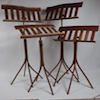Has anyone worked with American chestnut? I cut one down (it had died) and am having it milled. Whats its workability? I would have saved the wood anyway because while you can still find pockets of them up here, there is nowhere else you can get virgin lumber.




 Reply With Quote
Reply With Quote






